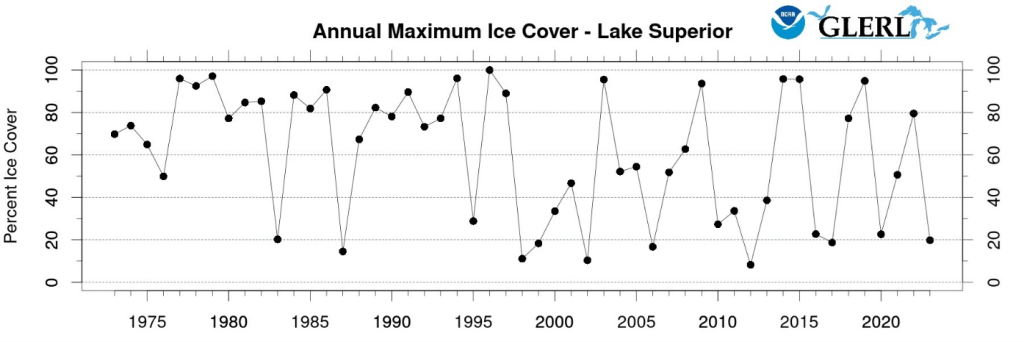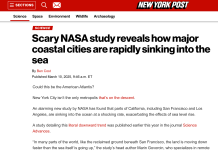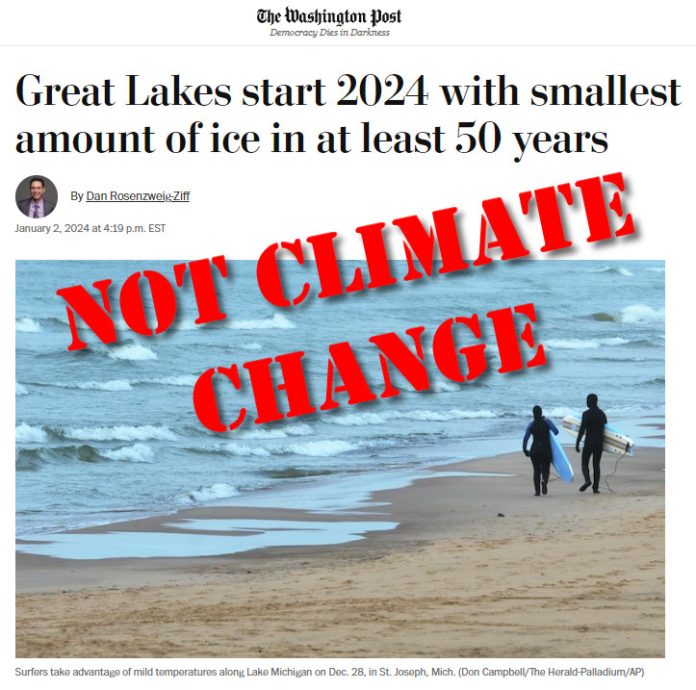The Washington Post published a story claiming the current low levels of ice coverage across the U.S. Great Lakes are a result of climate change. This is false. Data show that Great Lakes ice levels vary widely from year to year, and although this year’s current levels are low, that can change quickly, with the annual peak ice coverage not until March.
In the Washington Post story, “Great Lakes start 2024 with smallest amount of ice in at least 50 years,” reporter Dan Rosenzweig-Ziff writes:
The Great Lakes had the smallest amount of ice cover this New Year’s Day in at least the past 50 years and are on track to see less than the seasonal average this winter, according to government data. The decline comes during a five-decade drop in ice cover that experts say is due in part to human-caused climate change.
Rosenzweig-Ziff misses the ironic fact that the last time the Great Lakes ice coverage was this low in January was in the early 1970s, a time when global average temperatures were cooling, which many scientists claimed at the time could be a sign of a coming ice age. Warnings of the pending ice age were common in headlines at the time among mainstream media outlets.
Data from the National Oceanic and Atmospheric Administration’s Great Lakes Environmental Research Laboratory reveal that Great Lakes ice extent levels vary widely from year to year, forming and dissipating at different times throughout the years. (see the figure, below)
The same data also show that the Great Lakes exceeded 90 percent ice coverage five years between 2003 and 2023, during a period which mainstream media has claimed are the hottest decades on records. By comparison, from 1973 to 1993, when global average temperatures were cooler, the Great Lakes only exceeded 90 percent coverage in four years. (See the figure, below)
In short, Rosenzweig-Ziff and the Washington Post are playing chicken little to hype the “human climate change causes everything bad” narrative that they’ve been pushing for more than a decade; trying to link a single year’s slow start to ice coverage extent on the Great Lakes to climate change.
What the data show, however, is that there is no clear, sustained trend in declining ice coverage extent, which might be an indication of climate change. Instead, this year’s slow start to the Great Lakes ice season is an anomaly, not a unique event, experienced previously 50 years ago, despite the fact that temperatures then were modestly cooler on average than they are now.

















Distorted claims are all about influencing the public perception of climate change to the fanatics who believe all this nonsense. So what if ice flows are less and the reason it means nothing and shows that the earth has not changed one bit! What would you do about it burn less natural gas or by an EV and things will suddenly go back to normal! It’s all BS and no one or anything else has control!